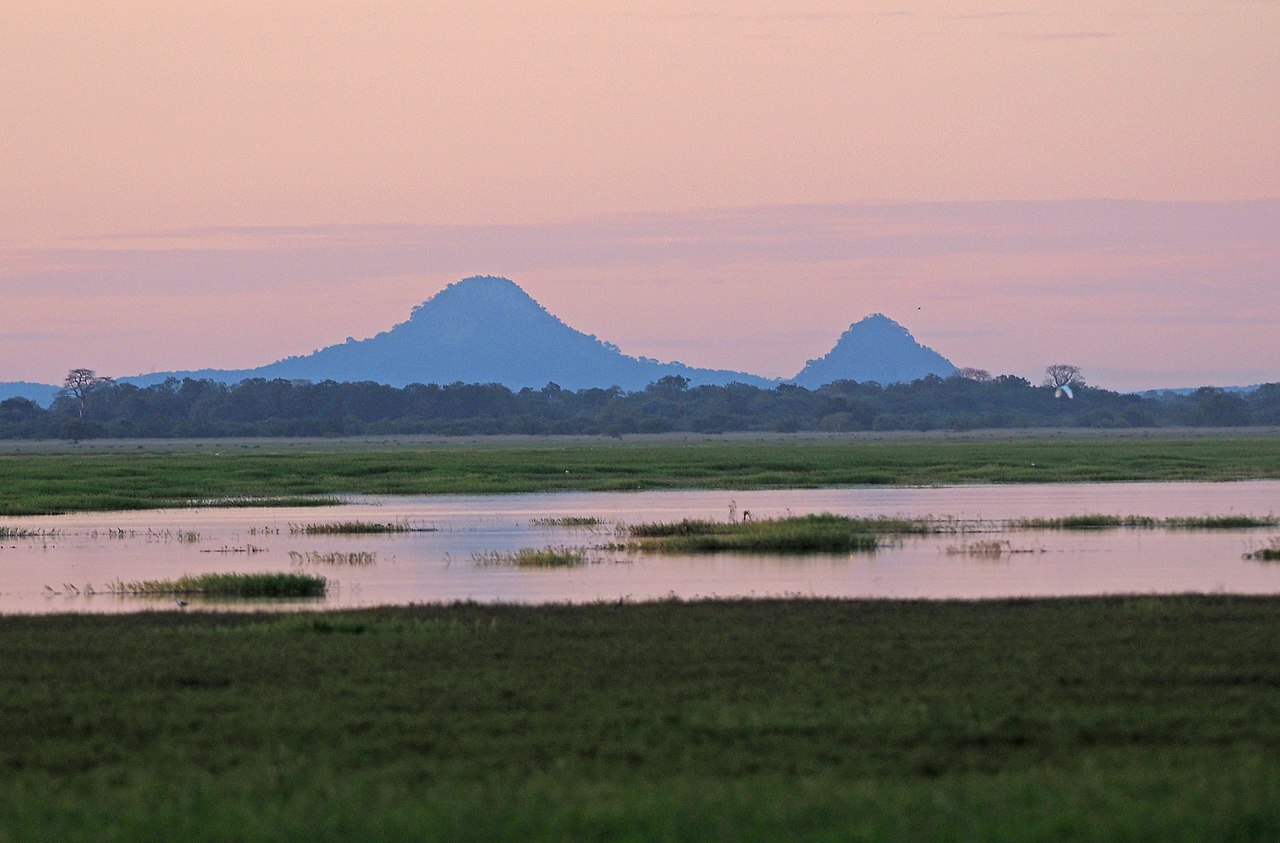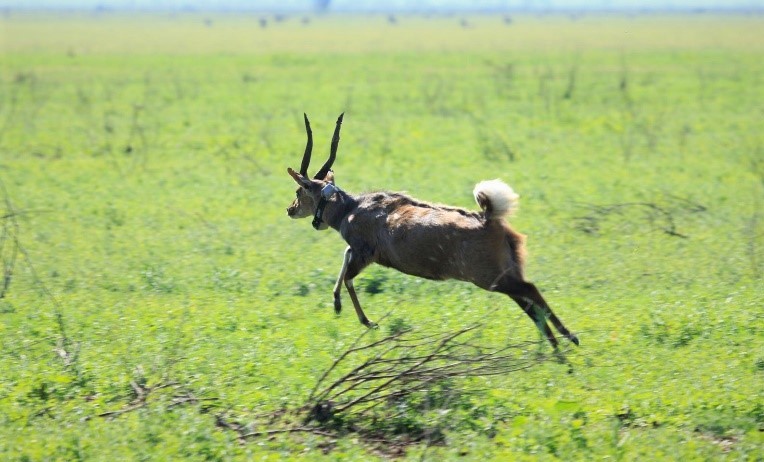- Bushbuck in Mozambique’s Gorongosa National Park have become increasingly fearless in their foraging habits, changing from foraging exclusively in woodland areas to braving open floodplains.
- Following years of civil war, populations of large herbivores and carnivores in Gorongosa declined by over 90 percent, with some top predators completely extirpated.
- Researchers from Princeton University conducted experiments using state-of-the-art equipment to establish whether the bushbucks’ use of floodplains for foraging was due to the decline in predation threat.
- Following experimentally simulated predation events, bushbuck significantly increased their use of tree cover, indicating that the reintroduction of top predators would restore a ‘landscape of fear’.
The ‘landscape of fear’ is not a new term among biologists. From the now-iconic study of how elk and bison gradually adjusted their vigilance levels after wolves were reintroduced into Yellowstone National Park, to the evaluation of grasshopper foraging habits in the presence of predatory spiders, the concept that prey species move and forage, in part, to avoid predators has been modeled, remodeled, and modeled again. However, seldom has there been an opportunity to observe the contrary, a ‘landscape of fearlessness’, following a dramatic decline in predator populations.
In May 1977, civil war broke out in Mozambique, prompting a 15-year conflict which ended in October 1992. Gorongosa National Park, known for its sprawling plains and diversity of wildlife, became one of the key battlefields in this conflict, with Mount Gorongosa itself being used as the base for Mozambican National Resistance (Renamo) fighters. While the park’s vegetation and soil emerged from the war relatively unscathed, it was a different story for its megafauna, populations of which had previously been lauded as the densest in Africa.

“Large carnivore populations suffered severe declines,” said Justine Atkins, a researcher from Princeton University studying animal movement behavior, “likely from a combination of by-catch in snares set for herbivores, loss of prey species/starvation, and human activity causing them to leave the area and seek refuge elsewhere.”
Populations of all monitored large carnivore and herbivore species of in Gorongosa had fallen by over 90 percent. The war left leopard, spotted hyena and African wild dog functionally extirpated, and the lion population at 65 individuals.
A survey in 2016 confirmed that large herbivore populations had been successfully restored to 80 percent of what were they were pre-war, and the lion population now boasts around 250 individuals. Other carnivores have not recovered similarly; the only sighting of a leopard since the end of the war occurred in March 2018. The extent to which their disappearance has affected the ecosystem is still unknown, but it was a group of brave bushbuck that gave researchers from Princeton University their first glimpse of the domino effect caused by Gorongosa’s carnivore extirpation.
The ‘landscape of fearlessness’
In 2015, during fieldwork for a project examining the behavior of antelope in Gorongosa, Atkins and her collaborators noticed that some of the animals were behaving unusually and straying from their typical habitat.
Between 1968 and 1972, Ken Tinley carried out a landmark survey of the fauna in Gorongosa National Park and documented bushbuck (Tragelaphus sylvaticus), a common antelope species, as “forest/thicket” foragers. However, Atkins and colleagues saw bushbuck foraging on open floodplains, outside the dense, sheltered woodland they were known to inhabit.

“Bushbuck had never been documented using this open habitat prior to the Mozambican civil war,” Atkins told Mongabay, “and we hypothesized that perhaps the absence of large carnivores in the park had allowed bushbuck to become more ‘fearless’ and occupy a habitat they would typically avoid in the presence of intact predator populations.”
Detailed in a recently released paper, Atkins and colleagues examined why bushbuck made the risky decision of straying onto open floodplains, whether the steep decline in carnivore presence was to blame, and what effect this change in herbivore ecology was having on the rest of the ecosystem.
Before the researchers could attempt any experimental manipulations, they fitted bushbuck from both woodland and floodplain habitats with collars carrying GPS satellite tags that provided the animals’ locations every 15 minutes, a necessity in the mostly roadless Gorongosa landscape.
“For the work that I do, technology is absolutely vital,” Atkins said. “Using recent advances in animal tracking technology and remote sensing of environmental data, we can now get more and better information on animal movement than ever before. Specifically, we can track animals at very fine scales and understand how they’re responding to their habitat at these small scales as well. This means that we can address questions that have previously been very difficult to assess with older tracking technology.”

Using the remote sensing data, the researchers identified two distinct patterns of habitat use among the tagged bushbuck; one group exclusively foraged within dense, wooded areas, another in treeless and sparsely wooded floodplains.
Atkins and her colleagues conducted predator vocalization playbacks and distributed artificial predator scat/urine in both the woodland and floodplain habitats “to create hotspots of simulated predation risk”, which they compared to playbacks of white noise as a control treatment.
When presented with predator cues, bushbuck that exclusively used open habitat retreated to the relative safety of the dense woodland. Furthermore, they didn’t change their behavior when presented with the white noise, proving that it was not the novelty of the sounds that had caused the move, but rather their fear-inducing qualities. Predators have not been present in Gorongosa for over two decades, yet the smell of artificial lion scat was enough to encourage bushbuck to abandon their usual foraging habitat and almost immediately take cover.
The grass is always greener
While fear of predation drives herbivores to forage in dense woodland, when the war eliminated that threat, what drove bushbuck to venture out into unchartered territory? Carnivore extirpation may well have increased bushbuck density, yet Atkins and colleagues ruled out the theory that increased competition inside woodland habitats prompted the novel behavior.

“Prey species have to balance the benefits of foraging in different habitats with the risk of being eaten in these habitats,” said Atkins. “Prey may avoid some habitats altogether if the risk is too high, regardless of the nutritional benefits to be potentially gained there.”
Using portal ultrasound and DNA metabarcoding technology, the researchers measured the body condition of the woodland and floodplain bushbuck by measuring fat on their rumps, and characterized each individual’s diet using fecal samples. They found that the floodplain bushbuck were in significantly better shape than their woodland counterparts, primarily because they were eating the leguminous shrub, Mimosa pigra. This previously overlooked resource dominated the diets of floodplain bushbuck, and for good reason. The plant provided bushbuck with more calories and significantly more protein than other food plants; the grass truly was greener.
A trophic cascade
The loss of carnivores in Gorongosa National Park triggered herbivores to explore territory that was once considered too risky and exploit resources that hadn’t been used when the landscape of fear presided. The researchers investigated whether the herbivore’s expansion into a high-risk, high-reward habitat had altered the flora which occurred there.
Bergia mossambicensis is the second-most abundant plant in the diets of floodplain bushbuck, and it seems they are keeping it all to themselves, as it makes up an insignificant portion of the diets of other large floodplain herbivores. This exclusivity made Bergia the perfect candidate to test the researchers’ hypothesis. They found that when excluded from herbivores, Bergia plants were larger and had significantly more flowers than those that were browsed, signs that the appearance of bushbuck on the floodplains suppressed the plants’ reproduction and growth.
Although researchers now know how carnivore extirpation has affected some of the flora in Gorongosa’s floodplains, this may be only the tip of the iceberg in terms of its long-term effects.

The research has brought hope that carefully curated reintroduction programs could help restore equilibrium in this war-torn park.
“We found that the decline of large carnivore populations in Gorongosa disrupted the normal ecosystem ‘rules’,” Atkins said, “but our predator simulation experiments lend support to the idea that restoration of apex predators to their natural ecosystems (or ‘rewilding’) can reestablish these indirect species interactions.”
In April 2018, scientists reintroduced a pack of African wild dogs into the park, the first wild dog reintroduction of its kind in Mozambique. As well as the planned reintroductions of wild dog, leopard, and spotted hyena, the park initiated a massive anti-poaching effort to give the newcomers a better chance to survive. The dedicated efforts of Gorongosa’s 230 rangers helped bring about a 60 percent decline in poaching pressure between 2016 and 2018.
Following the reintroduction of top predators, it seems that the floodplains of Gorongosa will return to their natural rhythm, with less browsing and more prowling. Atkins believes that her team’s unique documentation of a ‘landscape of fearlessness’, and their ongoing observations of the reinstatement of a ‘landscape of fear’, will help researchers studying similar systems,
“It’s a really exciting time to be a scientist in Gorongosa right now as we document the changes to the ecosystem that occur as large carnivores are re-introduced… Not only is [Gorongosa] a beautiful ecosystem, [but] it is also a really important experiment in large-scale restoration.”

Citation
Atkins, J. L., Long, R. A., Pansu, J., Daskin, J. H., Potter, A. B., Stalmans, M. E., … & Pringle, R. M. (2019). Cascading impacts of large-carnivore extirpation in an African ecosystem. Science, eaau3561. DOI: 10.1126/science.aau3561
FEEDBACK: Use this form to send a message to the editor of this post. If you want to post a public comment, you can do that at the bottom of the page.